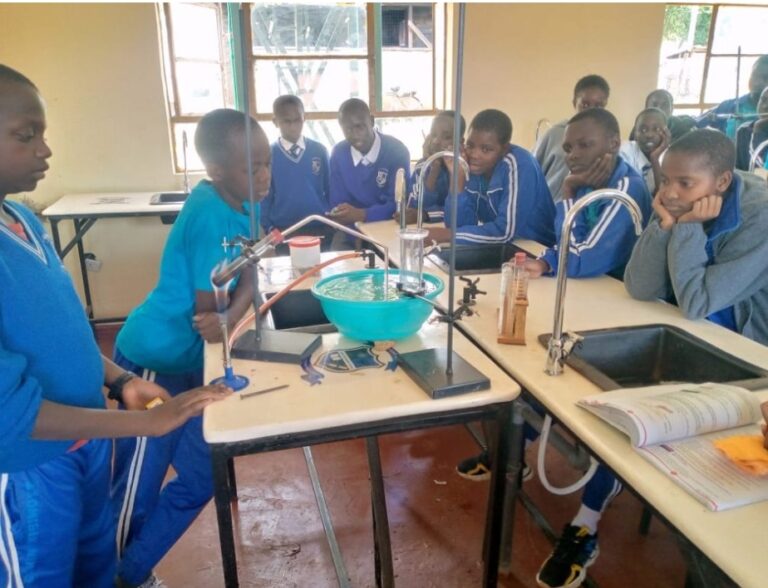Construction Of Grade 9 Classes And Labs Kicks Off. By the end of this year, the government plans to build at least 15,000 classrooms and laboratories to house the junior secondary school graduation class.
Ezekiel Machogu, the cabinet secretary for education, announced that the government would build the schools using Sh12 billion.
“In collaboration with Members of Parliament, the Government plans to invest Sh12.8 billion to help junior school construction of classrooms.” This year, 15,015 junior school classrooms should be prepared for use for Grade 9 students, according to the CS.
The CS hinted in December that the World Bank will contribute to the building of the JSS classrooms by giving an extra Sh9 billion to build 9,000 classrooms.
The government on the other hand, Machogu indicated, will provide Sh3.9 billion for the project.
Additional classes will be built by legislators under the National Government Constituency Development Fund (NG-CDF) kitty.
“We are taking steps to ensure that our schools have the necessary infrastructure, where our teachers and learners can effectively perform,” Machogu said.
Construction Of Grade 9 Classes And Labs Kicks Off
The Ministry of Education has already sensitized and trained primary school headteachers who will be in charge of the funds that will be used to build the classrooms.
The current Grade 8 learners will transition to Grade 9 in January next year to complete their junior level.
On the other hand the Kenya Institute of Curriculum Development (KICD) has clarified that Grade Nine is still domiciled in Junior School contrary to reports suggesting it has been moved to Senior School.
KICD chief executive Prof Charles Ong’ondo yesterday dismissed reports hinting at relocation of the learners to high school where senior school under Competency-Based Curriculum (CBC) is domiciled.
He said the Ministry of Education has made no such plan or pronouncement to move the current Grade 8 learners to high school next year.
“Parents, teachers and learners should not panic as the rumours do not hold any water. Changing the system or structure will tamper with the philosophical background, informed by research that gave direction to our current system in line with the changing global education trends,” he said in a statement
Prof said the CBC structure is informed by cognitive developmental theory, with basic education arrangement being that learners spend two years in pre-primary, six years in primary, three years in Junior School, and another three years in Senior School, hence 2-6-3-3 structure.
“The years have to match the development milestones of the children who are the targets of the learning system,” the KICD boss explained.
Construction Of Grade 9 Classes And Labs Kicks Off
He further noted that children’s thinking does not develop entirely smoothly, noting that there are certain points at which the thinking grows and moves into completely new dimensions-areas and capabilities.
The points are in four stages of cognitive development namely sensory-motor (0-2 years), language development and conceptual thought (2-7 years), concrete operations (7-11 years) and formal operations (11 years and above).
In the current CBC system of education in line with the Basic Education Curriculum Framework (KICD, 2027), Ong’ondo said that a child is supposed to join pre-primary at age four years where they are formed physically, mentally and socially to be able to start doing something and sharpening their interaction skills.
At this stage, the child learns basic literacy and numeracy.
At age six when the child joins Grade One, the child socialises with people around and the environment and should not be under academic pressure but be introduced to formal learning.
At 11, the learner is supposed to be in Grade Six, with Ong’ondo, saying from ages 11 to 15, they have formations that transform them from being children to adolescents.
“Learners in this age bracket need to be exposed to a broad-based curriculum to be able to explore. This is the essence of why Junior School was introduced for learners of ages 12 to 14 years old,” the CEO explained.
These learners are exposed to a broad-based curriculum where they do a little of everything before they can make up their minds about what they want.
He also explained that learners getting to Senior School start to focus on what they want to do in life.
“Senior School comprises three years of education targeted at learners in the age bracket of 15 to 17 years and lays the foundation for further education and training at the tertiary level and the world of work. It marks the end of Basic Education as defined in the Education Act, 2013,” he stated.
Ong’ondo said the current world requires transformative education that equips citizens with the necessary knowledge, skills, values and attitudes to address societal challenges.
“The role of education is more critical than ever in the increasing levels of violence and conflict, forced migration and climate change, as well as growing xenophobia, racism and discrimination,” said the CEO.
He affirmed that CBC is flexible, providing education pathways for identifying and nurturing talents and interests of learners early enough to prepare them for the world of work, career progression and sustainable development.
KICD reviewed designs in line with rationalised learning areas, with teachers expected to use the revised ones to implement the curriculum.
Construction Of Grade 9 Classes And Labs Kicks Off
“Using the designs, teachers can draw the content from these approved textbooks in teaching and learning. The reviewed designs are available on the KICD website,” said the CEO.
At the same time, he said the Ministry of Education has authorised KICD to call for Grades One, Two and Three books, which were last supplied in 2019 and are worn out.
“This also coincides with the technical lifespan of a curriculum. It is also time to look at the content and infuse the changes in line with the UNESCO rule of curriculum review after five years,” the CEO explained.
